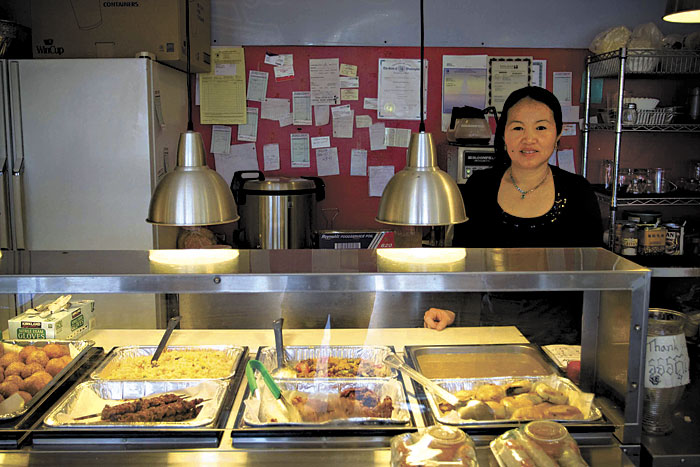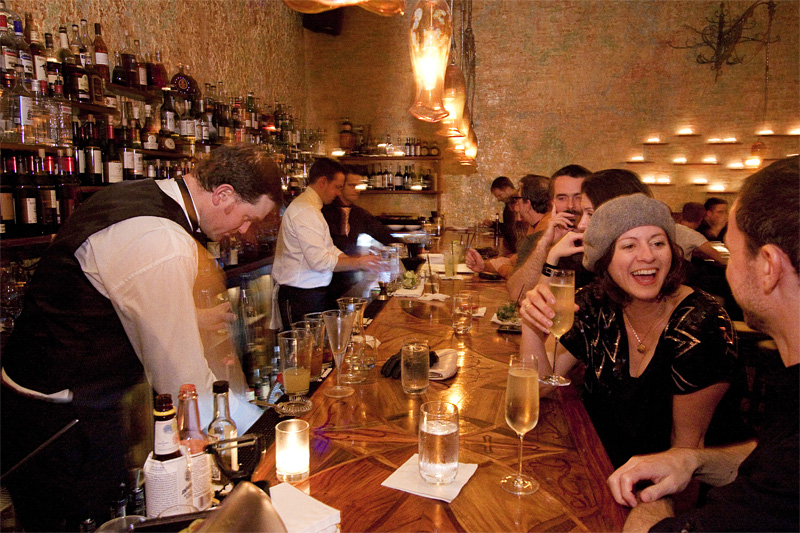Queen’s Deli may be the most attractive storefront on White Center’s 14th Avenue, a street where auto-body shops and strip malls alternate with strings of bungalows surrounded by chain-link fences. The deli shares a roof with one of those mini-markets whose success seems to depend on sales of calling cards and cigarettes. But with the deli’s salmon-colored exterior and brand-new sign, it’s the pretty head of the conjoined twins. If your standards are calibrated so high that a good paint job won’t make you pull over to take a closer look at the place, perhaps the printout taped to the window will. It says, simply, “Phnom Penh Noodles.”
White Center, one of the most interesting neighborhoods in the area if your taste in food runs to the cheap and piquant, is also the heart of Seattle’s Khmer community. The neighborhood is big enough to support three or four specialty markets, the offices of the Khmer-language newspaper, the Cambodian Cultural Alliance of Washington, and the Cambodian New Year’s festival—but nary a full-service restaurant, until now. And Queen’s Deli isn’t exactly a full-service restaurant. I’ve eaten there three times, and each time my friends and I have been the only occupied table for most of the meal, though a third of the tables around us have displayed the unexcavated remains of the parties who preceded us.
But we’re hardly alone. A steady stream of customers, almost everyone speaking Khmer, stops in for takeout. Women cluster around the cash register, swapping small talk with whomever’s manning the steam table, and finally walk out laden with plastic bags bulging with takeout containers. Men run in to pluck a paper-wrapped sandwich off the top of the counter, exchange nods with the owners, and dash out, no cash exchanged for the moment. The occasional teenage boy drops by to wolf down a bowl of noodles. At $5, it’s about the same price as a foot-long at the nearby Subway, and much, much better.
Phnom Penh noodles are so famous across Southeast Asia that many of the Vietnamese noodle shops in town serve them as well (the Vietnamese name is hu tieu nam vang—try a spectacular version at Tu Oanh on Jackson and 12th). Like pho, the soup comes with thin rice noodles, a slightly murky broth, and a plate of bean sprouts on the side to tip into the hot soup before you loosen up the noodle bundle and start slurping. The broth is rich with pork and toasted shallots, and as you stir the soup with your chopsticks, nuggets of ground pork and peeled prawns float to the surface, as well as squid scored to cook up resembling a tasseled flapper dress for a Playskool figurine.
I didn’t try the Phnom Penh noodles until my third trip to Queen’s Deli, though. There were too many other pictures on the laminated menu that caught my eye—dishes I’d never seen before. That first day, I ordered the numbanchuk, described as an old-fashioned Khmer dish containing pounded lemongrass, eggplant, and snake beans. Even though it cost $5, the cooks had to make the soup from scratch, and during that 30-40 minutes I had time to puzzle over why the posters on the wall were all in French and rifle through the pastries next to the counter.
The noodles came in two parts: one plate containing a twist of rice noodles and an undressed salad of shredded cabbage, Thai basil, julienned cucumbers, and finely chopped long (snake) beans, the other a large bowl of milky, celadon soup, thick with finely pounded herbs. The server brings a second, empty bowl to mix the two in.
The soup cooled the moment I tried stirring it into the raw vegetables and cold noodles, so I took to mixing the dish on my spoon. The flavor was entrancingly strange: soured with tamarind, perfumed with lemongrass, and dense with prahok, the preserved freshwater fish that plays the same role in Cambodian cooking as fermented soybeans in Korean cuisine and pig fat in Southern food. Prahok is a force more than a flavor—it’s the umami factor, the steak on the table when you don’t have enough money to slaughter a chicken. Anchovies on pizza taste too fishy for me, but prahok? Prahok I could add to anything.
The Khmer cuisine at Queen’s Deli isn’t all unfamiliar. Cambodia has been heavily influenced by the neighboring Thai, Vietnamese, and Chinese, not to mention the French. There’s pad thai on the menu, fried spring rolls the size of Dominican stogies, a respectable fried rice with shrimp, and a green-papaya salad that tastes almost like the one at any Royal Bangkok Jewel of Siam you order delivery from. All are priced between $5 and $7, ridiculously cheap even for White Center. Most of the dishes are cooked to order, though every time a customer orders something, the cooks make triple or quadruple the prescribed quantity, feeding the rest into the steam table for the next order to come along.
More often there are dishes whose pictures look familiar on the menu but whose taste is clearly skewed to a different culture’s palate. Beef satay I’ve had a hundred times. But theirs is marinated in a grainy paste of lemongrass and lime leaves with enough sugar in it to make every wrinkle of flesh char and crackle on the grill, the meat becoming as smokily perfumed as a Catholic church on Sunday. The fried fish looks Chinese but tastes far flashier than anything you’d find in Hong Kong. It’s coated in a multicolored haystack of stir-fried aromatics. To pluck away morsels of the flesh, you have to stab your chopsticks deep into the heap of slivered ginger, crimson chiles, and syrup-braised soybeans. Be sure to pick off some of the skin, fried to a bacony crunch.
And the coconut-milk cakes I ordered one night, I’d last seen at a Bangkok street stall whose tender ladled batter into cast-iron pans covered in egg-cup-sized divots. The Cambodian version of the tiny, custardy cakes, seasoned only with a few green flecks of scallion, was blander than the Thai, until we dipped them in a bowl of truk trei, a sweet-and-sour dipping sauce that resembles Vietnamese nuoc cham.
I left the deli with two things so amazing I’m adding them to my standard White Center shopping list, which already includes El Paisano’s carnitas, La Pasadita’s sopes, and buttery quesadilla (cheese-studded cornbread) from the Salvadoran Bakery. The first was a small plastic tub of red-brown meat sauce called prahok kh’tih, which the counterwoman told me I should microwave and eat with raw cucumbers and cabbage leaves.
“It smells, um, a little strong,” she warned.
So I opened the windows as I warmed it up, and within seconds my apartment reeked as much as when I have a couple of jars of kimchi open. Once I recovered from the wallop of prahok funk, I was bowled over by the ground pork and tiny bitter eggplants, minuscule chiles and lemongrass slivers. I mopped up the bowl with sticky rice, unwilling to waste a speck of the sauce, then turned on the fan.
The second was a bag of doughnuts. The women who work at Queen’s Deli will push the sesame balls on you, which are filled with sweet coconut and mung-bean paste. They’re good, but you should hit the deli at lunchtime, when the “lizard eggs” are hot out of the oil. The size and shape of duck eggs, these rice-flour ovals are covered in a crinkly sugar glaze and stuffed with a salted mung-bean purée flecked with chives. Is the doughnut savory or sweet? The impression shimmers and distorts like a highway on a 100-degree day, and any fan of Molly Moon’s salted caramel ice cream will understand the witchy appeal of that confusion. I took my first bite of a lizard egg as I pulled out of my parking spot, then put the car back in park until the last was gone.
Price Check Numbanchuk: $5 Phnom Penh noodles: $5 Beef satay: $5 for 5 Lizard eggs: $1.25 for 3






